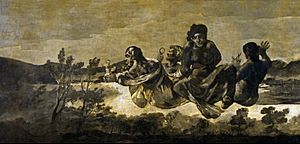Moirai facts for kids

The Moirai were three powerful goddesses in Greek mythology. They were also known as the Fates. These goddesses controlled the destiny of every person. Their names were Clotho, Lachesis, and Atropos. They decided how long someone would live. They also decided what would happen in that person's life.
The Moirai were so powerful that even the mighty god Zeus could not change their decisions. They held the threads of life for everyone. This included both humans and gods. When the Moirai made a choice, it was final.
Contents
The Moirai: Goddesses of Destiny
The Moirai were very important figures in ancient Greek beliefs. People believed these three sisters decided everything. They controlled a person's birth, life events, and even death. Their power was seen as greater than any other god's. This made them unique in the Greek pantheon.
Who Were the Moirai?
The Moirai were often shown as serious and wise women. They worked together to manage the lives of all beings. Each sister had a special job. This job was part of the process of life and destiny. They were not always seen as evil. Instead, they were seen as carrying out the natural order of the world.
The Three Sisters and Their Jobs
Each of the Moirai had a specific role in shaping destiny. Their tasks were connected to the metaphor of a thread. This thread represented a person's life.
Clotho: The Spinner
Clotho was the youngest of the three sisters. Her name means "the spinner." Clotho's job was to spin the thread of life. She would start a person's life by spinning this thread. This thread was like a person's beginning. It decided when and how someone would be born.
Lachesis: The Measurer
Lachesis was the second sister. Her name means "the appointer of lots" or "the measurer." Lachesis's job was to measure the thread of life. She decided how long a person's life would be. She also decided what events would happen in that life. She would measure out the good times and the bad times.
Atropos: The Cutter
Atropos was the oldest and most feared sister. Her name means "the unchangeable" or "the inevitable." Atropos's job was to cut the thread of life. When she cut the thread, a person's life ended. There was no way to stop her. Her decision meant death. She could even end the life of an immortal being.
Even Zeus Couldn't Change Fate
It was a common belief that no one could escape their fate. Not even the king of the gods, Zeus, could change what the Moirai decided. This showed how powerful they were. Their will was seen as the ultimate law of the universe. This idea taught people that some things are just meant to be.
Where Did They Come From?
The parents of the Moirai are not fully known. Some stories say they were the daughters of Zeus and the Titaness Themis. Themis was the goddess of law and order. Other stories say they were even older. They might have been the daughters of ancient beings. These include Nyx (Night), Chaos (the void), or Ananke (Necessity). This suggests their power came from the very beginning of time.
The Moirai in Roman Mythology
The ancient Romans also had goddesses of destiny. They were very similar to the Greek Moirai. The Romans called them the Parcae. They also had three sisters who controlled life and death. This shows how important the idea of fate was in ancient cultures.
Images for kids
-
Bas relief of Clotho, lampstand at the Supreme Court of the United States, Washington, D.C.
-
Bas relief of Lachesis, lampstand at the Supreme Court, Washington, D.C.
-
Bas relief of Atropos cutting the thread of life
-
The three Moirai, relief, grave of Alexander von der Mark by Johann Gottfried Schadow (Old National Gallery, Berlin)
-
Macbeth and Banquo meeting the three weird sisters in a woodcut from Holinshed's Chronicles.
-
A section of the Egyptian Book of the Dead written on papyrus showing the "Weighing of the Heart" in the Duat using the feather of Maat as the measure in balance.
See also
 In Spanish: Moiras para niños
In Spanish: Moiras para niños








